Is your website organized in a manner that makes sense not only to you but also site visitors within your target market? Nothing can be more frustrating than not being able to find information that you know is available on a site. When content is not where you expected it to be, your website will lose visitors and reputation of being a credible source of information.
Card sorting (and by extension, card sorting tools) is a convenient means of testing your site’s layout and finding out whether or not you need to make any changes that can improve your information architecture.
What Is Card Sorting?
Card sorting is a means of assisting in the design and evaluation of a site’s information architecture. Information architecture (IA) is the organization, structure, and labeling of content. Optimally, the information architecture should be effective and sustainable, with the intention of helping users to find information and complete tasks on your site.
Participants in a card sorting session will sort topics into groups in a way that makes sense to them, which helps you as the site owner or manager to organize your content. The categories recommended by your card sorting participants (whether a dedicated team or freelance volunteers) will sometimes come with the individuals’ recommendation for a new label.
Using the information gathered in a card sorting session, you’ll have a better idea of how to structure your site to cater to your target market. You’ll have a better understanding of how users perceive and group topics, which will allow you to categorize your content in a way that makes sense to them. If you’ve allowed for your card sorting participants to make suggestions on category names, you’ll also know how best to label each section so visitors to your site can easily make a connection between content and category.
Most importantly, you’ll know not only how to design your home page layout but also what exactly you ought to put on it. Having an informative and engaging home page, with easily identifiable links to each category and main content pages allow visitors to your site to know what to expect and how to find the information that they are seeking.
Card Sorting Types
- In an Open Card Sort, you ask your participants to group your website’s content in a way that makes sense to them, and then give each group a label that describes the category most accurately from their point of view. It is an excellent way to discover how your site’s target market perceive topics and how they think of them collectively (concerning the name they give to each group of items).
- With a Closed Card Sort, on the other hand, you provide the category labels and ask your participants to use these pre-defined headings while categorizing the content. This method is particularly useful if you already have your categories (which can often happen if you’re designing the site layout for an already existing website) but want to know how your target market understands each label.
A combination of both Open and Closed Card Sorting can be very useful.
Card Sorting Methods
One on One Card Sorting is a method involving two people, as the name implies: a participant and a facilitator, either yourself or someone you’ve assigned the task to. One on One Card Sorting gives participants the opportunity to think aloud as they categorize your content, which in turn will allow you a better understanding of their thought processes—and even their reactions. You can conduct a One on One Sort with physical cards or with an online tool, and the observer will be able to ask questions as they feel the need. This is particularly useful if you find your participants put content under a category you would never have expected them to: inquiring after their reasons for doing so will give you a better understanding than simply taking the sorting session’s results into consideration.
Independent Group Sorting allows you to conduct several one on one sessions at the same time using a single invigilator, who can brief the group before the session begins and then question individuals (or the group as a whole) afterwards. Each participant still works alone, with their set of cards or an assigned computer, depending on your chosen medium.
Integrated Group Sorting allows participants to gather in groups after the facilitator has briefed everyone, which can help the sorters to reach a consensus on a smaller level (if you split them into more than one group) and work with one set of cards or off a single computer. The facilitator can ask questions during the sorting process as need be, or at the end of the sorting period, but will certainly have to monitor on-going progress to help prevent one or two participants dominating the decision-making process.
Lastly, you can also conduct Remote Computer-based Sessions, which allow you to set up a general brief for participants to work within the comfort of their homes or offices. Using a card sorting software also gives you the advantage of having the results analyzed for you, but you may lose out on the opportunity to query any decisions that surprise you.
Using either (or both) Open Card Sorting or Closed Card Sorting is largely up to personal preference, and deciding on technique will also be influenced by your resources. It’s a good idea to conduct a software-based card sorting session split into two parts: an Open Sort to gather information on what content can go together, and a Closed Sort to test or decide on your labels, ensuring that they’re easily identifiable for your users.
Paper and Pen: Make Your Own
Whether you decide to conduct open, closed, or hybrid card sorting, and regardless of how you choose to hold your session (individual, integrated group, or independent group), you’ll still need to prepare your project.
The first step is choosing your material—try to find a thick card, like paper and thin cardboard can look not only cheap but also become worn, crumpled, or torn quite easily.

Next, you need to decide on the number of topics you want to have sorted. Most experts recommend limiting your selection to a maximum of 50 to 70, as greater numbers can and will be overwhelming for participants—especially if you’ve imposed a time limit. If your site requires more than 70 topics sorted, you should consider breaking it down into separate sessions.e sorted. Most experts recommend limiting your selection to a maximum of 50 to 70, as greater numbers can and will be overwhelming for participants—especially if you’ve imposed a time limit. If your site requires more than 70 topics sorted, you should consider breaking it down into separate sessions.
Then there’s the matter of the topics themselves. As far as possible, you should keep these short and to the point, so as to keep the cards easy to read without compromising on the information provided. You’ll also want to number them (for yourself, at least) for when you have to analyze them after the session, so you use a table or spreadsheet for listing your topics before creating the cards.
Card Sorting Tools
While hosting a card sorting session live has its merits, doing so online has the added benefit of allowing participants to do so at their pace (you can prescribe a time limit, of course) and in the comfort of their home or office. Better yet, you won’t have to sift through all the results yourself to analyze them—the software will do so for you, affording you more time to implement your new knowledge. So here’s nine online tools and methods that will help you to complete a card sorting.
1. Optimal Workshop’s OptimalSort
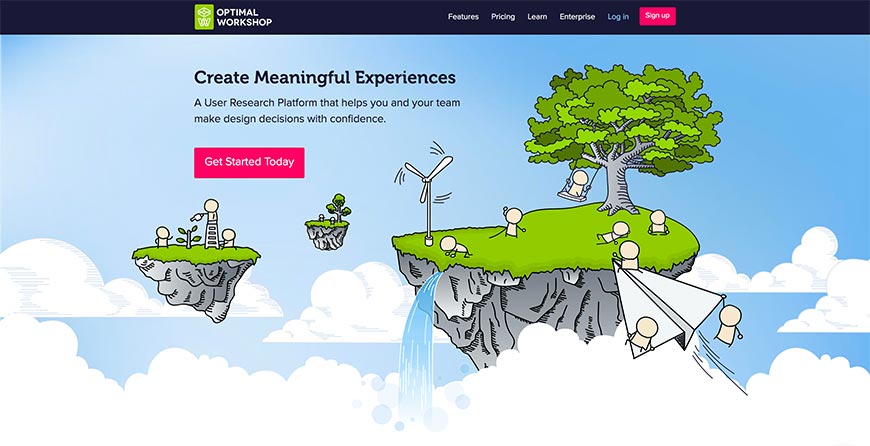
The Optimal Workshop suite is an incredibly resourceful online tool geared for helping you improve your site’s usability. Functions and features include assistance in deciding on website navigation and your information architecture, as well as understanding first clicks and helping you to conduct (and analyze) research. Most pertinent is the Optimal Workshop suite’s OptimalSort, which allows you to conduct online card sorting session.
First, you’ll create your cards—content items from your website (or content planned for posting online) that you want to have sorted by the public to ensure you categorize them in the best way possible. Next, you’ll have to opportunity to refine the options you want your participants to have and questions you want them to answer, either before or after they sort your content. The answers and choices they make here can help you to understand how different people sort your content, especially if your end results are very varied, allowing you to make the most informed decisions possible. Finally, you’ll need participants. With OptimalSort, you can send study links to your users via email, post the link on your site (or on social media), or use the suite’s integrated recruitment system.
As the results come in, OptimalSort will analyze them for you, and you’ll be able to download the report card with the software’s analysis spreadsheet for your convenience.
This tool is available with a free plan (with some strict limitations) as a trial option before deciding on the Suite Package or the Enterprise Package. The Enterprise Package is tailored to your specific needs, and you’ll have to contact the Optimal Workshop team for a quote, but the Suite Package is highly recommended at $166 per month (or annually, with a 20% discount).
2. Usability Tools - UX Suite
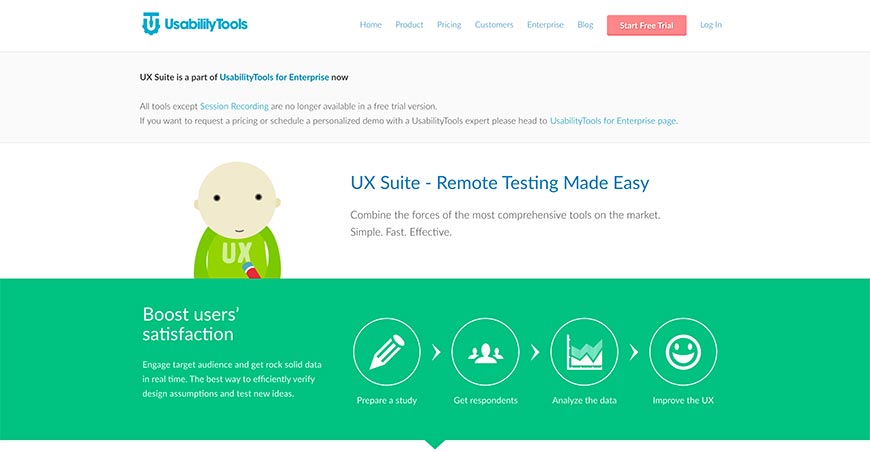
Originally a stand-alone project, UX Suite was integrated into the Usability Tools for Enterprise to allow for a more thorough research tool. There are no plugins or downloads necessary, as it’s entirely online, and you’ll have access to a host of features—including click testing to analyze your design, website testing to test your website’s optimization and receive suggested improvements, the ability to create and conduct surveys, and (of course) card sorting.
The UX Suite allows you to list topics and have participants sort them into categories of your choosing, so it’s a closed sorting tool. You’ll be given a link to post on your website, on social media, and/or make use of the Usability Tools for Enterprise’s integrated CINT research panel. In fact, their homepage offers you the opportunity to test the software as a participant, and your survey may feature there.
Your results are available in customizable charts, with tables and pie graphs included, which you can use for presentations at work or pitches to potential investors. You’ll also be able to export the raw data in .xls format if you prefer to analyze the report in more detail.
The Basic Package is naturally the most limited, but still very competent, and retails at $19 a month. The Growing Teams Package is by far the most popular option and offers double the data storage. Starting at $28 a month for 20 000 user sessions, pricing ranges up to $100 per month with 100 000 user sessions. Both packages offer a free trial period. The Enterprise Package is fully customizable and offers unlimited data storage, but you will need to contact the Usability Tools for Enterprise team for a quote.
3. User Zoom

User Zoom allows you to test your information architecture, using screenshot click tests, timeout tests, tree tests, and both Open Card and Closed Card sorting surveys to help you optimize your layout.
The User Zoom online card sorting tool allows you to reach participants who use desktops and tablets too. You’ll also receive in-depth analysis reports for all your tests, and the results are available swiftly, giving you the ability to share them with stakeholders and potential investors with ease.
The software developers understand that no two clients have exactly the same needs, and have created a highly flexible tool that you can shape and mold in order to receive the results you need in a way you understand.
After building your cards, you’ll be able to recruit participants via User Zoom’s integrated panels and the software’s global panel partnerships, but you’ll also have the option of sharing your session on your site and sending invitations, without requiring that you or any participants pay a recruitment fee. When using the panels, User Zoom goes the extra mile by directing representatives of your intended target market to your session, so that you won’t have to worry about participants who don’t form your clientele (or potential clientele) and therefore wouldn’t be able to give you qualitative suggestions.
The software developers understand that no two clients have exactly the same needs, and have created a highly flexible tool that you can shape and mold in order to receive the results you need in a way you understand. Because User Zoom is so easily adaptable to your specific needs, there is no fixed pricing plan, so you’ll have to request a quote.
4. Uzilla Mozdev Card Sorting Tool
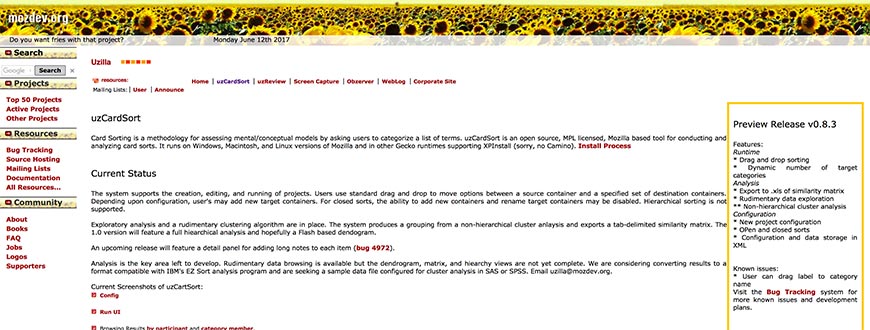
The Uzilla Mozdev Card Sorting Tool is an open-source installation Mozilla based software that is fully compatible with Windows, Macintosh, and Linux. Using UzCardSort, you can create and edit your own card sorting projects, where users are asked to drag topic options into a specified set of category blocks. If you prefer Open Sorting, you’ll be able to configure your survey to allow participants to add new labels, but you do have the option of disabling this feature for Closed Sorting.
The analysis aspect of UzCardSoft is not as detailed or expansive as with some of the others on our list, but as the software grows it is starting to integrate new features such as hierarchical analysis—and a Flash based dendrogram is said to be in the works as well. You will be able to configure and store your gathered data in XML, and export it as an .xls file for further analysis and sharing.
Installation and use does require that you use Mozilla, which is an increasingly popular browser alternative for Google Chrome, Windows Internet Explorer, and Mac’s Safari, and you’ll need to start by downloading their support library, JSLib. After installing the UzCardSort software library too, you’ll also need to restart Mozilla and navigate to chrome://uzcardsort/content/index.xul to run the tool, which can seem like a bit of a mission—but considering the Uzilla Mozdev Card Sorting application is entirely free of charge (and doesn’t take up much space), it’s a worthy software for any Mozilla user.
5. xSort App
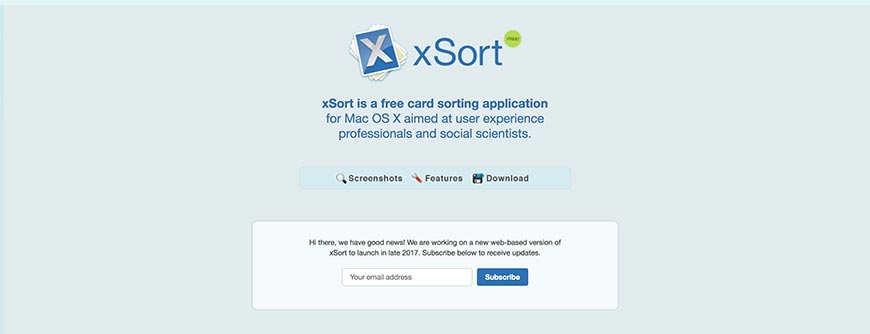
The xSort App is a free installation card sorting tool designed for Macintosh. Your card sorting session simulates a table with cards to achieve the visual aesthetic that Apple products are known for, and the software supports Open and Closed sorting types alike—as well as a combination of the two. Participants will also be able to create sub-categories if they feel the need, which can help you to create drop-tab menus that make site navigation even simpler.
Aside from having full control over all your sessions, including the option to lock the session so a participant can’t repeat the same survey, you’ll also be able to view updated results in real time. Reports are easily accessible, and you can manually create them as you need. You’ll be able to read, print and export a statistical analysis of your results that are easy to understand with a single click at any time you choose.
User experience professionals, social scientists, and novice webmasters and site owners alike will all find the xSort App gives users a thoroughly satisfactory experience, so no matter your level or expertise you’ll find it a welcome and necessary tool in optimizing your website.
The developers are also looking to publish a web-based version of the xSort App to negate the need to download and install the software. Of course, you do need to be a Macintosh user to be able to use the software, but participants will be able to take part and contribute no matter their working platform.
6. UsibiliTest
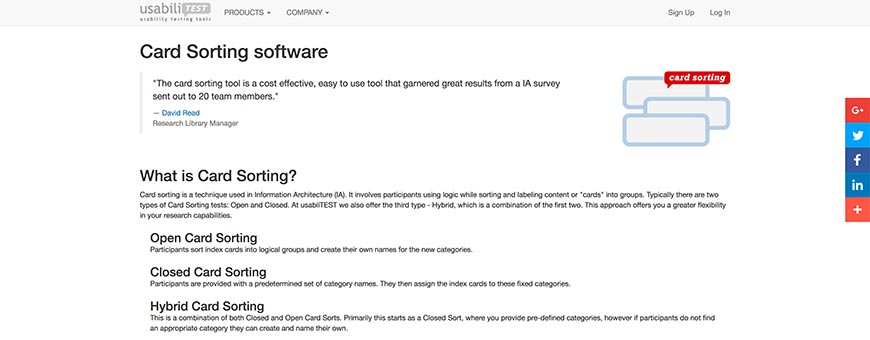
UsabiliTest is another online card sorting tool designed to be easy to use without compromising on the quality and thoroughness of your resultant reports, which are generated for you with the software’s built-in analysis tools.
Within seconds, you’ll be able to set up your own usability test and card sorting session, using Open Sorting, Closed Sorting, or a mix of both, which you can password protect (meaning participants are limited to invitation only) or leave open to public access. If you already have a list of topics you want to test, you can upload the list in one easy go—but if you’re picking up on subjects as you go along, you can easily enter each one individually.
UsabiliTest will allow you to import your address book to send an invitation to your contacts (which the app then tracks, notifying you when anyone of your invites result in an active participant), but you can also share a link on your site or social media.
The built-in analysis tool also auto-generates results in real time, and allows you to view statistics in numerical and percentile format, plotting them of a graph or categorizing them for you. You’ll also be able to export the results for use in presentations and sales pitches, and if you prefer using outside statistical tools (or want a second opinion) you’ll be able to export the raw data with ease.
UsabiliTest offers a free 48-hour trial without any limitations, after which you can choose between the Pro Package ($24.95 a month) and the Premium ($224.55 a year—three months free version of Pro).
7. Simple Card Sort

Available as an online sorting tool, Simple Card Sort is another software available that allows you to create Open Sort, Closed Sort, or Hybrid Sort surveys, with customized messaging and branding.
You’ll be able to share the link you your card sorting session on your site, social media, and via email, allowing participants to drag and drop their selection and comment on their decision making process no matter where they are—and if you’ve enabled subgroups, they can create their own subcategories. You can also give participants the option to rename the categories you’ve provided, allowing you to further refine and optimize your site. The results are saved and updated as each participant completes his or her individual session, and Simple Card Sort gives you the option of analyzing them using their tables or to download the raw data to a spreadsheet for personal analysis.
For the best results, Simple Card Sort allows you to create unlimited online sessions, where you can change the type, filters, and get more participants involved on the same set of topics as need be.
Simple Card Sort offers a limited free demo account so you can test the software before committing to a subscription. The Basic subscription can last 30 days ($49.99) or 60 ($89.99), but to enjoy the full benefits of the tool we recommend opting for a 30 day ($99.99) or 60 day ($179.99) Pro subscription, as the Basic doesn’t allow for much customization or the ability to add sub-groups.
8. UXSort

UXSort is an open-source installation card sorting tool compatible with Windows (up to Windows 8 only at present, but the developers are reportedly working on a patch for Windows 10).
You’ll be able to import a list of cards using Word or Excel, and UXSort allows you to sort up to 1000 cards. Participants will be able to click and drag cards into automated categories, and the results are updated in real time. Reports can be exported and merged, and will include participant information.
Each user’s results are presented and exported individually, but the system allows you to group results together and run a cluster analysis. The final report (which you can update as new participants complete the session) is presented in the form of a dendrogram—otherwise known as a family tree.
You do need to have some basic understanding of SQL databases, as the software installation includes SQL Compact, but is very easy to use and understand otherwise. Installation shouldn’t take longer than ten minutes, and the UXSort site offers a full step-by-step explanation to guide you through the process.
Their site does warn that Windows 7 is currently still the preferred operating system, and that results may not always be accurate depending on the site’s complexity. In agreement with the developers, we recommend that you use UXSoft results as a basis for further research and discussion with your web manager and domain experts rather than as a definite reflection of changes that can and should be made.
If you’re looking for a general idea of how to categorize your site’s content without feeling that you ought to follow the card sorting tool’s suggestions exactly, then UXSoft could be the software for you.
9. The NIST Web Metrics Testbed - Web Category Analysis Tool (WebCAT)
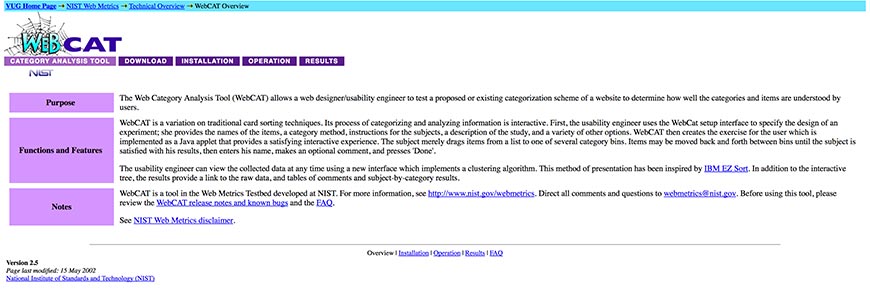
The NIST Web Metrics Testbed in an open source online card sorting tool designed to cover every aspect of optimizing your layout, information architecture, and categorization. Their Web Category Analysis Tool (WebCAT) enables you as the site manager, developer, or owner to test how intuitive your categories are laid out and content placed, whether you’re using an existing layout or still planning one.
When designing your card sorting session, you will have full control over the design and layout—how topic cards and category buckets look. You will also be able to list your content headings, specify a category method, post instructions for participants, and even add a description of your site if you so wish. As usual, participants click and drag cards into the category buckets as they feel appropriate, and are able to move cards from one category to another should they change their mind. Once complete, he or she is asked to provide their name and offered the opportunity to leave a comment (this is entirely optional, but comments can give you further insight) before submitting their input.
As the initiator of the sessions, you’ll be able to view collected data at your convenience using the integrated clustering algorithm and interactive tree. These results include a link to the raw information gathered (in case you want to use an external analysis tool), subject by category reports, and a table of any comments that participants left.
Conclusion
Using an online card sorting tool isn’t only going to provide you with important information for optimizing your site’s layout, but thanks to the interactive software we’ve listed it can also be a fun experience for your participants.
It’s important that you pick a card sorting tool that works for you, and we hope that our list of recommendations makes your decision-making process easier—so you can spend less time looking for a tool, and more time optimizing your site.
Related Articles
- 18 Usability Guidelines and Website Design Standards
- UX Tools
- Focus Groups: Everything You Need to Know
- How to Perform a Usability Evaluation
- Top 15 User Experience (UX) Certification Programs
- The Definitive Guide to Card Sorting
- 43 Awesome Ultraprecise, Proven AB Testing Tools
- 5 Tips for Creating an Exceptional Website
- 10 Excellent Books About Information Architecture
- How to Wireframe a Responsive Website Design
- 16 Usability Testing Tools for Optimizing User Experience
- 20 Ways To Increase Your Website Conversions
- How Personas Can Help Your Content Strategy
- How to Evaluate the Quality of Your Website Design
- UX Careers 101: The Guide to User Experience Careers
- How to Effectively Plan Your Website's Architecture
- Sitemap Generator + Google Analytics = A User Experience Architect's Dream
Create Visual Sitemaps
Create, edit, customize, and share visual sitemaps integrated with Google Analytics for easy discovery, planning, and collaboration.
Popular Tags
Search Engine Optimization SEO Accessibility Testing Create Sitemaps Sitemaps UX User Experience Sitemap Generator Content Audit Visual Sitemap GeneratorGet Started with DYNO Mapper
Join thousands of professionals using the most advanced visual sitemap tool to simplify discovery, IA, and content planning.
👉 Start Your Free Trial — No credit card required.




